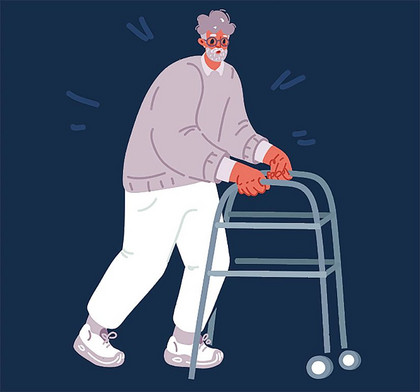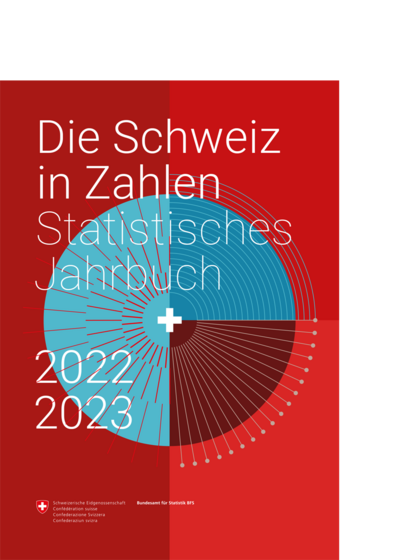
Switzerland: an ageing, happy country of solo households
The 2022–2023 Statistical Yearbook provides a snapshot of Switzerland. A country of strong demographic growth, solely due to immigration. The people consider themselves happy. They are also highly mobile: everyone has a car.

85 years old
An ageing country
Switzerland is an ageing country, and the population is no longer self-sustaining, as there are more deaths than births. At the start of the twentieth century, Switzerland averaged 3.7 births per woman, compared to 1.39 today. A rate of 2.1 births per woman is needed to sustain the population. The country’s growth is thus attributable to its foreign nationals. The population of Switzerland grew from 4.717 million in 1950 to 7.204 million in 2000. It passed the eight million mark in 2020, rising to nine million in 2023: a European growth record! The age pyramid is inexorably inverting. Between 1900 and 2022, the proportion of young people aged under 20 decreased by half, from 40.7% to 19.9%. Over the same period, the proportion of the population over the age of 64 rose from 5.8% to 19.2%. The share of people aged 80 and over actually increased multiple times over, rising from 0.5% to 5.5%.
In 2022, Switzerland had 1,948 centenarians, three-quarters of whom were women. And their number keeps growing. One third of girls born in 2022 should reach the age of 100. Life expectancy at birth has doubled since the end of the nineteenth century. A baby girl born in 1950 had a life expectancy of 70 years, compared to 85 years today. Of course, ageing is not good for the health, and half of the population suffers from long-term health issues from the age of 75. Nonetheless, Switzerland’s senior citizens seem happy for the most part. In 2021, almost two persons in five – from the age of 16 – said they were very satisfied with their life. And this feeling of wellbeing increases with age (not to mention level of education and income). However, this age imbalance poses massive challenges to the social insurance system, as the proportion of people paying contributions is in decline. There will also, at least in relative terms, be fewer health professionals to ensure that these cohorts of elderly people receive adequate healthcare.

20%
A country of single-person households
The richer a country is, the more people live alone. Wealthy Switzerland is no exception. Over one third of Switzerland’s one million households comprise one person. In other words, almost 20% of the permanent resident population live alone. Households without children have more than doubled since 1970. At the same time, single-person households have tripled. That said, even if family households with children represent less than a third of the total, they still account for 41% of the population. As for single-parent households, they account for 16% of all family households. Do people like living alone? It seems that those who live with a partner, with or without children, are a lot more content with life than those who live alone or as a single parent. In 2010, it was estimated that one marriage in two risked ending in divorce. Going by current forecasts, that statistic is now two marriages in five. Finally, more women than men are subjected to violence. In 2022, the police recorded a total of 42 homicides, 25 of which took place within the home. 18 of these 25 casualties were female.

26%
A country with a large foreign population
In 2022, 26% of Switzerland’s permanent residents did not hold a Swiss passport. But almost one fifth of these foreign residents were born in Switzerland. In the same year, 40% of the permanent resident population aged fifteen or over comprised people from a migratory background. Granted, this does include something unique in Europe – apart from Luxembourg and its 47% of foreign nationals – the contribution of cross-border workers, which has increased spectacularly in some regions. One example is the number of French cross-border workers, which increased from fewer than 80,000 persons before 2005 to almost 220,000 in 2022.
Net migration peaked in 1961 at over 100,000 persons. The figure for 2021 was 61,500 persons. This transition has been ongoing since 1999, when international migration became the main demographic growth driver, conclusively overtaking natural growth. Moreover, in 2020 61,000 Swiss babies were born in Switzerland as against 24,900 non-Swiss births. The biggest foreign communities are from Italy, Germany and Portugal. This is reflected in the languages spoken, as the proportion of persons speaking Italian (23%) is the same as for people speaking other languages than the four national ones. As regards asylum, there were 24,511 asylum applications in 2022, which is close to what the average has been for the past 25 years (22,500 applicants). These asylum seekers are mainly from Afghanistan, Turkey, Eritrea and Syria. In addition to this total, there are about 66,000 Ukrainian refugees who had protected status with S permits at the end of 2023.

6.6 million
A highly motorised country
Life expectancy is a sign of a rich country. So is mobility. The Swiss move around a lot. In 2021, they covered an average of 30 km per person daily within the country. Most of the daily distances covered within the country – 69% in 2021 – are by car. Leisure pursuits are the main reason for mobility, accounting for 43% of kilometres travelled. Next comes work (28%). In 2022, Switzerland had almost 6.6 million registered motorised vehicles, 4.7 million of which were passenger cars and 800,000 motorcycles. Since 1980, the number of passenger cars has more than doubled and there are almost six times as many motorcycles. Road transport costs amount to 76.8 billion in total, considerably more than rail transport costs (12.1 billion). In 2022, there were 18,396 accidents on Swiss roads: 241 people lost their lives, 4,002 were severely injured and 17,896 slightly hurt. Motorised transport is largely powered by fossil fuel (93% in 2022). In 2021, motorised transport accounted for 38% of CO2 emissions in Switzerland (excluding international aviation).

“Much like a compass, the Swiss Statistical Yearbook can help guide you on a journey of discovery through Switzerland.” That is how the Director General of the Federal Statistical Office, Georges-Simon Ulrich, describes the latest edition of this statistics bible. The yearbook is a whole 412 pages long and covers a whole raft of subjects. We cover three of the main ones here, which relate to demography, immigration and mobility and include a detailed section on CO2 emissions.
In German: Die Schweiz in Zahlen - Statistisches Jahrbuch 2022/2023; Erscheinungsdatum 30. November 2023, ISBN 978-3-303-00720-4, 412 Seiten, CHF 90.–


Comments